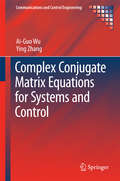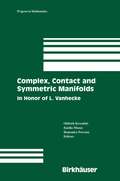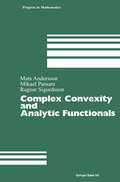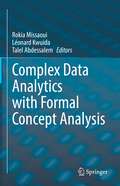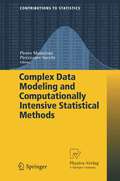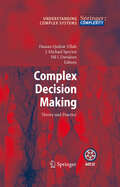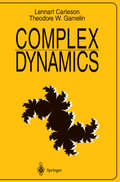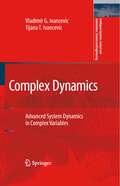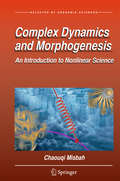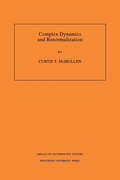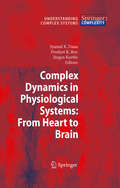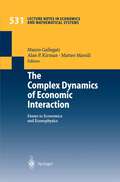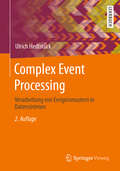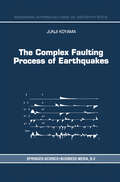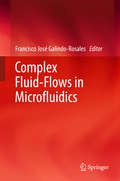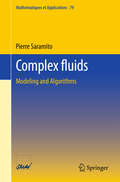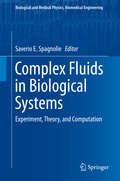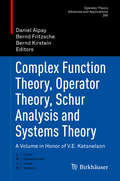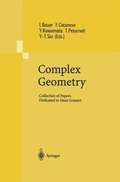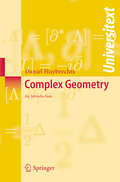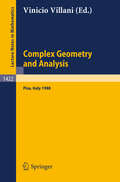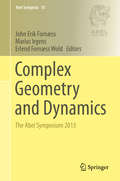- Table View
- List View
Complex Conjugate Matrix Equations for Systems and Control (Communications and Control Engineering)
by Ai-Guo Wu Ying ZhangThe book is the first book on complex matrix equations including the conjugate of unknown matrices. The study of these conjugate matrix equations is motivated by the investigations on stabilization and model reference tracking control for discrete-time antilinear systems, which are a particular kind of complex system with structure constraints. It proposes useful approaches to obtain iterative solutions or explicit solutions for several types of complex conjugate matrix equation. It observes that there are some significant differences between the real/complex matrix equations and the complex conjugate matrix equations. For example, the solvability of a real Sylvester matrix equation can be characterized by matrix similarity; however, the solvability of the con-Sylvester matrix equation in complex conjugate form is related to the concept of con-similarity. In addition, the new concept of conjugate product for complex polynomial matrices is also proposed in order to establish a unified approach for solving a type of complex matrix equation.
Complex, Contact and Symmetric Manifolds: In Honor of L. Vanhecke (Progress in Mathematics #234)
by Oldrich Kowalski Emilio E. Musso Domenico Perrone* Contains research and survey articles by well known and respected mathematicians on recent developments and research trends in differential geometry and topology * Dedicated in honor of Lieven Vanhecke, as a tribute to his many fruitful and inspiring contributions to these fields * Papers include all necessary introductory and contextual material to appeal to non-specialists, as well as researchers and differential geometers
Complex Convexity and Analytic Functionals (Progress in Mathematics #225)
by Mats Andersson Mikael Passare Ragnar SigurdssonThis book puts the modern theory of complex linear convexity on a solid footing, and gives a thorough and up-to-date survey of its current status. Applications include the Fantappié transformation of analytic functionals, integral representation formulas, polynomial interpolation, and solutions to linear partial differential equations.
Complex Data Analytics with Formal Concept Analysis
by Rokia Missaoui Léonard Kwuida Talel AbdessalemFCA is an important formalism that is associated with a variety of research areas such as lattice theory, knowledge representation, data mining, machine learning, and semantic Web. It is successfully exploited in an increasing number of application domains such as software engineering, information retrieval, social network analysis, and bioinformatics. Its mathematical power comes from its concept lattice formalization in which each element in the lattice captures a formal concept while the whole structure represents a conceptual hierarchy that offers browsing, clustering and association rule mining.Complex data analytics refers to advanced methods and tools for mining and analyzing data with complex structures such as XML/Json data, text and image data, multidimensional data, graphs, sequences and streaming data. It also covers visualization mechanisms used to highlight the discovered knowledge.This edited book examines a set of important and relevant research directions in complex data management, and updates the contribution of the FCA community in analyzing complex and large data such as knowledge graphs and interlinked contexts. For example, Formal Concept Analysis and some of its extensions are exploited, revisited and coupled with recent processing parallel and distributed paradigms to maximize the benefits in analyzing large data.
Complex Data Modeling and Computationally Intensive Statistical Methods (Contributions to Statistics)
by Pietro Mantovan Piercesare SecchiComplex Decision Making: Theory and Practice (Understanding Complex Systems)
by Hassan Qudrat-Ullah J. Michael Spector Paal DavidsenToday's ever more complex world creates challenges for decision makers. This volume reviews the principles underlying complex decision making, the handling of uncertainties in dynamic environments, and the various modeling approaches. Beginning with a discussion of the underlying concepts, theories and empirical evidence, the book gives you a range of practical tools and techniques for decision making in complex environments and systems.
Complex Dynamics (Universitext)
by Lennart Carleson Theodore W. GamelinA discussion of the properties of conformal mappings in the complex plane, closely related to the study of fractals and chaos. Indeed, the book ends in a detailed study of the famous Mandelbrot set, which describes very general properties of such mappings. Focusing on the analytic side of this contemporary subject, the text was developed from a course taught over several semesters and aims to help students and instructors to familiarize themselves with complex dynamics. Topics covered include: conformal and quasi-conformal mappings, fixed points and conjugations, basic rational iteration, classification of periodic components, critical points and expanding maps, some applications of conformal mappings, the local geometry of the Fatou set, and quadratic polynomials and the Mandelbrot set.
Complex Dynamics: Advanced System Dynamics in Complex Variables (Intelligent Systems, Control and Automation: Science and Engineering #34)
by Vladimir G. Ivancevic Tijana T. IvancevicComplex Dynamics: Advanced System Dynamics in Complex Variables is a graduate-level monographic textbook. It has seven Chapters. The introductory Chapter 1 explains ‘in plain English’ the objective of the book and provides the preliminaries in complex numbers and variables; it also gives a soft introduction to quantum dynamics. Chapter 2 develops low-dimensional dynamics in the complex plane, theoretical and computational, continuous- and discrete-time. Chapter 3 presents a modern introduction to quantum dynamics, mainly following Dirac's notation. Chapter 4 develops geometrical machinery of complex manifolds, essential for the further text. Chapter 5 develops high-dimensional complex continuous dynamics, which takes place on complex manifolds. Chapter 6 develops the formalism of complex path integrals, which extends the continuous dynamics to the general high-dimensional dynamics, which can be both discrete and stochastic. In the last, Chapter 7, all previously developed methods are employed to present the ‘Holy Grail’ of modern physical and cosmological science, the search for the ‘theory of everything’ and the ‘true’ cosmological dynamics.
Complex Dynamics and Morphogenesis: An Introduction to Nonlinear Science
by Chaouqi MisbahThis book offers an introduction to the physics of nonlinear phenomena through two complementary approaches: bifurcation theory and catastrophe theory. Readers will be gradually introduced to the language and formalisms of nonlinear sciences, which constitute the framework to describe complex systems. The difficulty with complex systems is that their evolution cannot be fully predicted because of the interdependence and interactions between their different components. Starting with simple examples and working toward an increasing level of universalization, the work explores diverse scenarios of bifurcations and elementary catastrophes which characterize the qualitative behavior of nonlinear systems. The study of temporal evolution is undertaken using the equations that characterize stationary or oscillatory solutions, while spatial analysis introduces the fascinating problem of morphogenesis. Accessible to undergraduate university students in any discipline concerned with nonlinear phenomena (physics, mathematics, chemistry, geology, economy, etc.), this work provides a wealth of information for teachers and researchers in these various fields. Chaouqi Misbah is a senior researcher at the CNRS (National Centre of Scientific Research in France). His work spans from pattern formation in nonlinear science to complex fluids and biophysics. In 2002 he received a major award from the French Academy of Science for his achievements and in 2003 Grenoble University honoured him with a gold medal. Leader of a group of around 40 scientists, he is a member of the editorial board of the French Academy of Science since 2013 and also holds numerous national and international responsibilities.
Complex Dynamics and Renormalization (AM-135), Volume 135 (PDF)
by Curtis T. McmullenAddressing researchers and graduate students in the active meeting ground of analysis, geometry, and dynamics, this book presents a study of renormalization of quadratic polynomials and a rapid introduction to techniques in complex dynamics. Its central concern is the structure of an infinitely renormalizable quadratic polynomial f(z) = z2 + c. As discovered by Feigenbaum, such a mapping exhibits a repetition of form at infinitely many scales. Drawing on universal estimates in hyperbolic geometry, this work gives an analysis of the limiting forms that can occur and develops a rigidity criterion for the polynomial f. This criterion supports general conjectures about the behavior of rational maps and the structure of the Mandelbrot set. The course of the main argument entails many facets of modern complex dynamics. Included are foundational results in geometric function theory, quasiconformal mappings, and hyperbolic geometry. Most of the tools are discussed in the setting of general polynomials and rational maps.
Complex Dynamics in Physiological Systems: From Heart to Brain (Understanding Complex Systems)
by Syamal K. Dana Prodyot K. Roy Jürgen KurthsNonlinear dynamics has become an important field of research in recent years in many areas of the natural sciences. In particular, it has potential applications in biology and medicine; nonlinear data analysis has helped to detect the progress of cardiac disease, physiological disorders, for example episodes of epilepsy, and others. This book focuses on the current trends of research concerning the prediction of sudden cardiac death and the onset of epileptic seizures, using the nonlinear analysis based on ECG and EEG data. Topics covered include the analysis of cardiac models and neural models. The book is a collection of recent research papers by leading physicists, mathematicians, cardiologists and neurobiologists who are actively involved in using the concepts of nonlinear dynamics to explore the functional behaviours of heart and brain under normal and pathological conditions. This collection is intended for students in physics, mathematics and medical sciences, and researchers in interdisciplinary areas of physics and biology.
The Complex Dynamics of Economic Interaction: Essays in Economics and Econophysics (Lecture Notes in Economics and Mathematical Systems #531)
by Mauro Gallegati Alan P. Kirman Matteo MarsiliThe economy is examined by the authors as a complex interactive system. The emphasis is on the direct interaction between agents rather than on the indirect and autonomous interaction through the market mechanism. Contributions from economists and physicists emphasise the consequences for aggregate behaviour of the interaction between agents with limited rationality. Models of financial markets which exhibit many of the stylised facts of empirical markets such as bubbles, herd behaviour and long memory are presented. This includes contributions on bargaining, buyer-seller relations, the evolution of economic networks and several aspects of macro-economic behaviour. This book will be of interest to all those interested in the foundations of collective social and economic behaviour and in particular, to those concerned with the dynamics of market behaviour and recent applications of physics to economics.
Complex Effects in Large Eddy Simulations (Lecture Notes in Computational Science and Engineering #56)
by Parviz Moin Stavros Kassinos Carlos Langer Gianluca IaccarinoThe field of Large Eddy Simulations is reaching a level of maturity that brings this approach to the mainstream of engineering computations, while it opens opportunities and challenges. The main objective of this volume is to bring together leading experts in presenting the state-of-the-art and emerging approaches for treating complex effects in LES. A common theme throughout is the role of LES in the context of multiscale modeling and simulation.
Complex Engineered Systems: Science Meets Technology (Understanding Complex Systems)
by Dan Braha Ali A. Minai Yaneer Bar-YamThis book sheds light on the large-scale engineering systems that shape and guide our everyday lives. It does this by bringing together the latest research and practice defining the emerging field of Complex Engineered Systems. Understanding, designing, building and controlling such complex systems is going to be a central challenge for engineers in the coming decades. This book is a step toward addressing that challenge.
Complex Event Processing: Verarbeitung von Ereignismustern in Datenströmen
by Ulrich HedtstückEine wichtige Aufgabe für die IT der vernetzten Welt ist die maschinelle Auswertung und Verarbeitung von Informationen, die für eine Anwendung relevant sind und übers Netz verschickt werden. Mit Complex Event Processing (CEP) können große Mengen von zeitbehafteten Daten unterschiedlichster Art in nahezu Echtzeit analysiert und weiterverarbeitet werden. Die grundlegende Vorgehensweise beim CEP entspricht der menschlichen Entscheidungsfindung in Prozessabläufen des täglichen Lebens und stellt eine Erweiterung bekannter Methoden des Data Analytics wie Data Mining, statistische Analyse oder regelbasierte Wissensverarbeitung dar. Typische Anwendungsgebiete sind Big-Data-Systeme, Internet of Things, Industrie 4.0.
The Complex Faulting Process of Earthquakes (Modern Approaches in Geophysics #16)
by J. KoyamaIn seismology an earthquake source is described in terms of a fault with a particular rupture size. The faulting process of large earthquakes has been investigated in the last two decades through analyses of long-period seismo grams produced by advanced digital seismometry. By long-period far-field approximation, the earthquake source has been represented by physical parameters such as s~ismic moment, fault dimension and earthquake mag nitude. Meanwhile, destruction often results from strong ground motion due to large earthquakes at short distances. Since periods of strong ground motion are far shorter than those of seismic waves at teleseismic distances, the theory of long-period source process of earthquakes cannot be applied directly to strong ground motion at short distances. The excitation and propagation of high-frequency seismic waves are of special interest in recent earthquake seismology. In particular, the descrip tion and simulation of strong ground motion are very important not only for problems directly relevant to earthquake engineering, but also to the frac ture mechanics of earthquake faulting. Understanding of earthquake sources has been developed by investigating the complexity of faulting processes for the case of large earthquakes. Laboratory results on rock failures have also advanced the understanding of faulting mechanisms. Various attempts have been made to simulate, theoretically and empirically, the propagation of short-period seismic waves in the heterogeneous real earth.
Complex Fluid-Flows in Microfluidics
by Francisco José Galindo-RosalesThis monograph contains expert knowledge on complex fluid-flows in microfluidic devices. The topical spectrum includes, but is not limited to, aspects such as the analysis, experimental characterization, numerical simulations and numerical optimization. The target audience primarily comprises researchers who intend to embark on activities in microfluidics. The book can also be beneficial as supplementary reading in graduate courses.
Complex fluids: Modeling and Algorithms (Mathématiques et Applications #79)
by Pierre SaramitoThis book presents a comprehensive overview of the modeling of complex fluids, including many common substances, such as toothpaste, hair gel, mayonnaise, liquid foam, cement and blood, which cannot be described by Navier-Stokes equations. It also offers an up-to-date mathematical and numerical analysis of the corresponding equations, as well as several practical numerical algorithms and software solutions for the approximation of the solutions. It discusses industrial (molten plastics, forming process), geophysical (mud flows, volcanic lava, glaciers and snow avalanches), and biological (blood flows, tissues) modeling applications. This book is a valuable resource for undergraduate students and researchers in applied mathematics, mechanical engineering and physics.
Complex Fluids in Biological Systems: Experiment, Theory, and Computation (Biological and Medical Physics, Biomedical Engineering)
by Saverio E. SpagnolieThis book serves as an introduction to the continuum mechanics and mathematical modeling of complex fluids in living systems. The form and function of living systems are intimately tied to the nature of surrounding fluid environments, which commonly exhibit nonlinear and history dependent responses to forces and displacements. With ever-increasing capabilities in the visualization and manipulation of biological systems, research on the fundamental phenomena, models, measurements, and analysis of complex fluids has taken a number of exciting directions. In this book, many of the world’s foremost experts explore key topics such as:Macro- and micro-rheological techniques for measuring the material properties of complex biofluids and the subtleties of data interpretationExperimental observations and rheology of complex biological materials, including mucus, cell membranes, the cytoskeleton, and bloodThe motility of microorganisms in complex fluids and the dynamics of active suspensionsChallenges and solutions in the numerical simulation of biologically relevant complex fluid flowsThis volume will be accessible to advanced undergraduate and beginning graduate students in engineering, mathematics, biology, and the physical sciences, but will appeal to anyone interested in the intricate and beautiful nature of complex fluids in the context of living systems.
Complex Function Theory, Operator Theory, Schur Analysis and Systems Theory: A Volume in Honor of V.E. Katsnelson (Operator Theory: Advances and Applications #280)
by Daniel Alpay Bernd Fritzsche Bernd KirsteinThis book is dedicated to Victor Emmanuilovich Katsnelson on the occasion of his 75th birthday and celebrates his broad mathematical interests and contributions.Victor Emmanuilovich’s mathematical career has been based mainly at the Kharkov University and the Weizmann Institute. However, it also included a one-year guest professorship at Leipzig University in 1991, which led to him establishing close research contacts with the Schur analysis group in Leipzig, a collaboration that still continues today.Reflecting these three periods in Victor Emmanuilovich's career, present and former colleagues have contributed to this book with research inspired by him and presentations on their joint work. Contributions include papers in function theory (Favorov-Golinskii, Friedland-Goldman-Yomdin, Kheifets-Yuditskii) , Schur analysis, moment problems and related topics (Boiko-Dubovoy, Dyukarev, Fritzsche-Kirstein-Mädler), extension of linear operators and linear relations (Dijksma-Langer, Hassi-de Snoo, Hassi -Wietsma) and non-commutative analysis (Ball-Bolotnikov, Cho-Jorgensen).
Complex General Relativity (Fundamental Theories of Physics #69)
by Giampiero EspositoThis book is written for theoretical and mathematical physicists and mat- maticians interested in recent developments in complex general relativity and their application to classical and quantum gravity. Calculations are presented by paying attention to those details normally omitted in research papers, for pedagogical r- sons. Familiarity with fibre-bundle theory is certainly helpful, but in many cases I only rely on two-spinor calculus and conformally invariant concepts in gravitational physics. The key concepts the book is devoted to are complex manifolds, spinor techniques, conformal gravity, ?-planes, ?-surfaces, Penrose transform, complex 3 1 – – space-time models with non-vanishing torsion, spin- fields and spin- potentials. 2 2 Problems have been inserted at the end, to help the reader to check his und- standing of these topics. Thus, I can find at least four reasons for writing yet another book on spinor and twistor methods in general relativity: (i) to write a textbook useful to - ginning graduate students and research workers, where two-component spinor c- culus is the unifying mathematical language.
Complex Geometry: Collection of Papers Dedicated to Hans Grauert
by Ingrid Bauer F. Catanese Y. Kawamata Thomas Peternell Y. T. SiuThis volume contains a collection of research papers dedicated to Hans Grauert on the occasion of his seventieth birthday. Hans Grauert is a pioneer in modern complex analysis, continuing the il lustrious German tradition in function theory of several complex variables of Weierstrass, Behnke, Thullen, Stein, Siegel, and many others. When Grauert came on the scene in the early 1950's, function theory was going through a revolutionary period with the geometric theory of complex spaces still in its embryonic stage. A rich theory evolved with the joint efforts of many great mathematicians including Oka, Kodaira, Cartan, and Serre. The Car tan Seminar in Paris and the Kodaira Seminar provided important venues an for its development. Grauert, together with Andreotti and Remmert, took active part in the latter. In his career he has nurtured a great number of his own doctoral students as well as other young mathematicians in his field from allover the world. For a couple of decades his work blazed the trail and set the research agenda in several complex variables worldwide. Among his many fundamentally important contributions, which are too numerous to completely enumerate here, are: 1. The complete clarification of various notions of complex spaces. 2. The solution of the general Levi problem and his work on pseudo convexity for general manifolds. 3. The theory of exceptional analytic sets. 4. The Oka principle for holomorphic bundles. 5. The proof of the Mordell conjecture for function fields. 6. The direct image theorem for coherent sheaves.
Complex Geometry: An Introduction (Universitext)
by Daniel HuybrechtsEasily accessible Includes recent developments Assumes very little knowledge of differentiable manifolds and functional analysis Particular emphasis on topics related to mirror symmetry (SUSY, Kaehler-Einstein metrics, Tian-Todorov lemma)
Complex Geometry and Analysis: Proceedings of the International Symposium in honour of Edoardo Vesentini, held in Pisa (Italy), May 23 - 27, 1988 (Lecture Notes in Mathematics #1422)
by Vinicio VillaniThe volume contains the texts of the main talks delivered at the International Symposium on Complex Geometry and Analysis held in Pisa, May 23-27, 1988. The Symposium was organized on the occasion of the sixtieth birthday of Edoardo Vesentini. The aim of the lectures was to describe the present situation, the recent developments and research trends for several relevant topics in the field. The contributions are by distinguished mathematicians who have actively collaborated with the mathematical school in Pisa over the past thirty years.
Complex Geometry and Dynamics: The Abel Symposium 2013 (Abel Symposia #10)
by John Erik Fornæss Marius Irgens Erlend Fornæss WoldThis book focuses on complex geometry and covers highly active topics centered around geometric problems in several complex variables and complex dynamics, written by some of the world’s leading experts in their respective fields.This book features research and expository contributions from the 2013 Abel Symposium, held at the Norwegian University of Science and Technology Trondheim on July 2-5, 2013. The purpose of the symposium was to present the state of the art on the topics, and to discuss future research directions.
